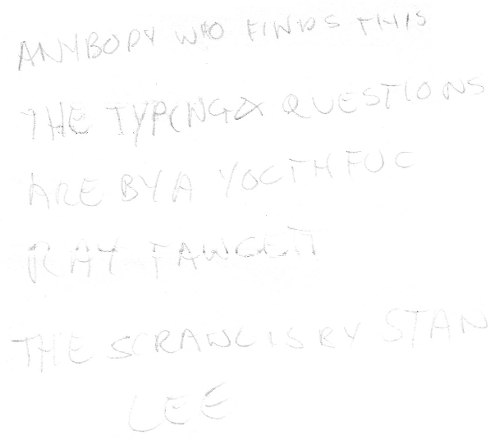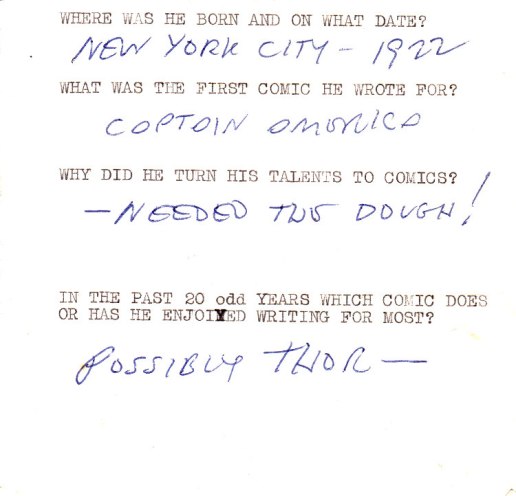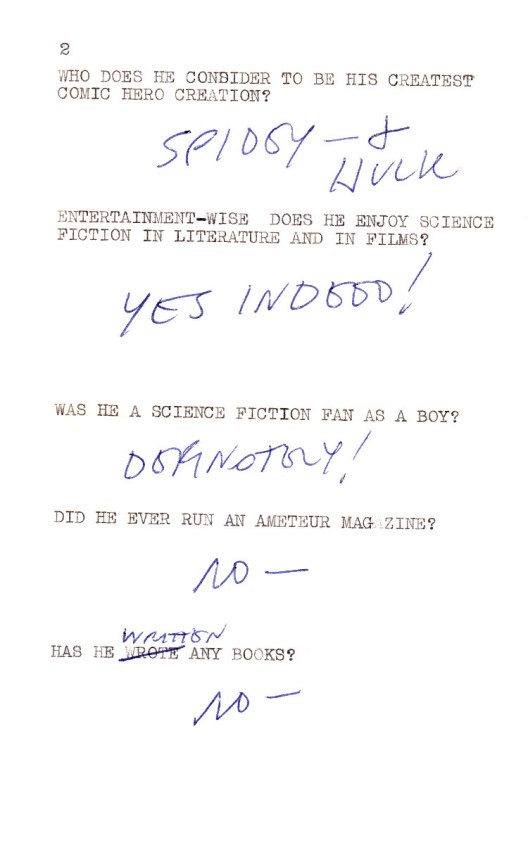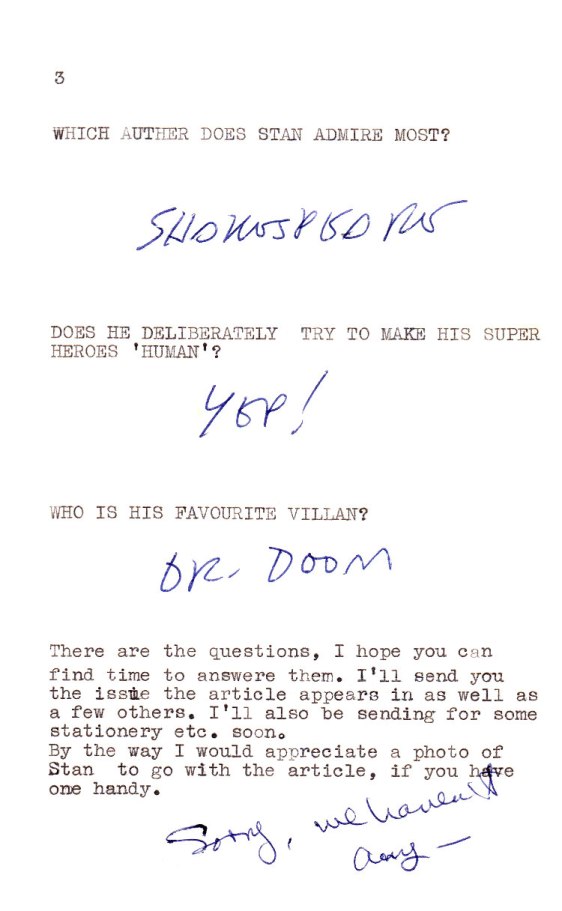One tip towards owning a collection.
Despite the title above this story doesn’t start with Stan Lee. Well get get to him in due course don’t worry, Stan Lee is inevitable after all, but first there needs to be some scene setting.
Like any profession the folk who deal in the buying and selling of second-hand books can recite a litany of peeves and dislikes in regards to their work. Not surprisingly most of these complaints revolve around the behaviour of the general public. Not you, I hasten to add, I’ve no doubt that if you’re reading this then you are the thoughtful and discerning type who wouldn’t dream of adding to a book dealer’s woes. Even so it’s possible for the average collector to miss a few tricks, some of which may surprise you. Consider for example the following complaint lifted from a private mailing list:
You need to add to that list the frustration of being offered a recently inherited collection only to discover that before calling the seller has thrown away everything they assumed was irrelevant rubbish. Why somebody not familiar with a collection and who usually has little or no interest in the subject the collection is built around assumes they are the best qualified person to decided what is valuable and what is not is beyond me. People don’t understand about ephemera!
This is not the most common complaint from book dealers (that belongs to members of the public with an unrealistic belief as to the value of what they’re offering for sale) but I’ve seen the matter of ephemera brought up more than once.
So what is ephemera? To put it simply ephemera is the term used for any written or printed matter not meant to be retained or preserved. Usually this refers to material such as posters, handbills, sales catalogues, invoices, and the like. When it comes to book collecting the term is generally taken to also include anything relating to an author or the book trade in general. Manuscripts, letters, newspaper clippings, photographs etc are all generally considered to be ephemera.
Unfortunately for those of us who like ephemera (and also those libraries and other institutions that collect such material) the general public assumes ephemeral material has no value. So when such people encounter, for example, promotional material produced by publishers or book stores they throw this ‘rubbish’ away without realising that these unassuming scraps of paper are frequently both rare and the repositories of useful historical data.
Of course not everything that finds its way into a collection is worth preserving. Some years ago I discovered in a book I’d borrowed from the local public library the printout of an email a previous borrower had left there, presumably as a bookmark. As the email contained sufficient detail about the sender I posted the printout to their address along with a polite note suggesting they be more careful in the future.
Sometimes though what comes unannounced is interesting in it’s own right. Some years ago I purchased Jon White’s copy of The Eighth Stage Of Fandom by Robert Bloch. What I wasn’t told by the seller was that between it’s pages was a note from Bloch himself. Jon White was a noted New York dealer is science fiction books and magazines for many years so I don’t suppose you will be entirely surprised to see the note from Bloch was a request to purchase copies of two magazines. A quick search on the Internet Science Fiction Database revealed that the two magazines requested were issues in which stories by Bloch had appeared.

I won’t try to convince you, gentle reader, that this note is in any way valuable but I think it adds to the book I found it in. It’s not just another copy of The Eighth Stage Of Fandom, because this copy comes with the mystery of why Robert Bloch would be searching for those magazines nearly twenty years after they had been published. Well I enjoy speculating on such matters anyway.
A note from a author in a book of their writings isn’t all that unlikely, especially if the author was, like Robert Bloch, a prolific writer of notes and letters. There was another time though that I found something truly unexpected. It was in 2013, not long after I had received a package from a UK dealer which contained various British fanzines published back in the fifties and sixties. Inside an issue of The Eye #3, a fanzine published in December 1954 by Tedd Tubb and other members of the London Circle, I discovered some folded and very flimsy scraps of paper. They don’t look like much but none-the-less I looked at them closely. Somebody had saved these scraps for a reason and being the sort of person I am I assumed I would find that reason interesting.
The outer layer was a sheet of notepaper which had belonged to somebody called Ray Fawcett. That much was obvious because printed at the top of the sheet was:
RAY FAWCETT
EDITOR
Below that was an address in Addiscombe, an area of South London. So far so boring. On the other side though very faintly scrawled was gold:

To save your eyes from strain what’s written above is as follows:
Anybody who finds this
The typing & questions are by a youthful Ray Fawcett
The scrawl is by Stan Lee
So, Stan Lee at last, because on the other two thin and flimsy scraps are a series of typed questions to which very brief answers have indeed been scrawled. Before we get to the questions and answers though, let me point out that just because these papers were tucked inside a fanzine from the fifties that doesn’t mean the papers were from that era. A quick search on eBay, revealed that the seller I bought my fanzines from also auctioned off a copy of Sanctuary 2.1, a fanzine published by Ray Fawcett. Mostly likely then this seller had acquired part of Ray Fawcett’s collection and that the fanzines I bought were obtained by Fawcett second-hand. However why he later put these papers, which judging by the references made to comic books (Tom Servo. “They’re not comic books! They’re graphic novels!”) can’t date from earlier than the mid-sixties within the pages of something published more than a decade before is anybody’s guess.
So now that I’ve made that clear just what did the youthful Ray Fawcett ask Mr Lee?

Is it just me or is it strange (no Tom Servo, not Doctor Strange) that Ray Fawcett refers to Stan Lee in the third person? I don’t know how old Fawcett was at the time but I’m guessing in his early teens to judge by his own description of ‘youthful’ and some of the spelling mistakes in the typing. Perhaps he felt a bit overawed by the thought of addressing somebody who even back in the sixties was considered a god among men by many Marvel fans.


It’s a pity that Stan Lee’s scrawl is so very scrawly if only because I’d really like to know who the author is that Stan admires the most. If anybody can decipher those barely formed letters and provide me with an answer I will be most grateful.
As for Ray Fawcett’s place in the scheme of things the earliest mention of him I’m aware of is in Skyrack #93 (published by Ron Bennett in November 1966) in which ‘fanzine editors Ray Fawcett and Bram Stokes’ are mentioned as having attended the Horror Film Club of Great Britain’s First Annual Convention. I then used a bit of triangulation by searching on Ray Fawcett and Bram Stokes simultaneously. You want to find somebody in my experience look for their friends too, it eliminates so much chaff. Anyway this search turned up several mentions of a fantasy/horror fanzine called Gothique. Apparently Derek ‘Bram’ Stokes had been one of the editors and Ray Fawcett one of the writers.
I mentioned my discovery to various people and as usual it turned out that Mark Plummer was able to add to the story for me. Searching through a copy of Gothique #6 in his possession he discovered mention of various Ray Fawcett fanzines.To quote Mark quoting from Gothique:
The reviews aren’t all that positive. Dave Griffiths doesn’t seem impressed with Fawcett’s ‘ramble [in Ash] on how great his magazine is and how much it’s improved’. He agrees it has improved but feels it’s down to Fawcett’s readers to say that. Griffiths also reviews Hero, an heroic fantasy fanzine. This is mostly given over to to denouncing Fawcett for spelling Elric ‘Erlic’ but apparently the issue also included ‘an article on Stan Lee, comic strip writer, something I’ve never seen before’.
It seems pretty clear to me then that the papers I have here were used by Ray Fawcett to write that article about Stan Lee mentioned as being included in Hero #1. Again, like the Bloch note, I wouldn’t try to convince you that these sheets of paper have any significant value, Stan Lee didn’t even add his signature after all. On the other hand what this discover lacks in cash value it makes up with an interesting story.
And that’s why collections should not be approached as carcasses to be stripped and the prime cuts sold to the highest bidder. Instead they should be approached with care lest you trample right over the best stories they contain.
Remember, always tread carefully and carry a big search.

I think the scrawled name of the author Stan Lee most admired is “Shakespeare.” Verily.
LikeLike
Thank you for that Denny. Shakespeare would make sense now I think about it.
LikeLike